
Dolichorhynchops osborni
Williston 1902- Holotype Specimen
Copyright ©2009 by Mike Everhart
Last revised 09/18/2009
LEFT: Holotype specimen of Dolichorhynchops osborni, KUVP 1300 (Click photo to enlarge)
SYSTEMATIC PALEONTOLOGY SAUROPTERYGIA Owen, 1860 PLESIOSAURIA de Blainville, 1835 PLESIOSAUROIDEA Welles, 1943 POLYCOTYLIDAE Williston 1908 Dolichorhynchops Williston 1902 Holotype Species—Dolichorhynchops osborni Williston 1902 |
According to Williston (1902), the
holotype of Dolichorhynchops osborni (KUVP 1300) was discovered by George F.
Sternberg in 1901 in the upper Smoky Hill Chalk of Logan County, and collected by his
father, Charles H. Sternberg (see also Sternberg's account (1909, p. 111-112)). G.F. Sternberg was 17 years old at the
time. The specimen disarticulated when found and collected in a large slab of chalk. The
remains were purchased by the University of Kansas, where they were subsequently prepared
and mounted by H.T. Martin under the direction of Dr. S.W. Williston. The skull of KUVP 1300 is crushed laterally (lying
on its left side) but is well-preserved and complete except for some damage to the right (upper) side due to
weathering (missing the right maxilla). The
sclerotic ring around the left eye was still in place. The specimen was described by
Williston (1902), including a single
photograph of the specimen as mounted in right lateral view. Williston regarded the
skull as being too fragile to use in the skeletal mount, so a 3-dimensional plaster skull was prepared
and used in its place. The original skull was
on exhibit originally but has since been removed to storage in the collections. Here
is Williston's (1914) view of what he thought Dolichorhynchops
would look like in life. Williston reported on KUVP 1300 again in 1903, this time with line drawings of the skull by Sidney Prentice and an extensive array of photographs. Although initially named Dolichorhynchops (“long snout face”), after comparing the specimen with Trinacromerum, Williston (1908) revised the name to Trinacromerum osborni, hence the mis-leading sign in the exhibit. After Welles (1962) re-established Dolichorhynchops as a valid genus, Bonner (1964) and Adams (1977, 1977) added to the confusion regarding the correct genus name. Carpenter (1996) separated the two genera chronostratigraphically, with Dolichorhynchops being the most recent. |
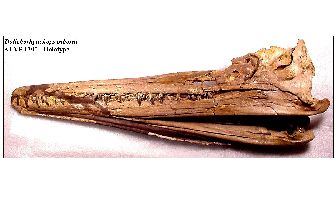 |
LEFT: The holotype skull of Dolichorhynchops osborni (KUVP 1300) in left lateral view. Note that this was the lower side of the skull as collected and is somewhat better preserved than the right side. |
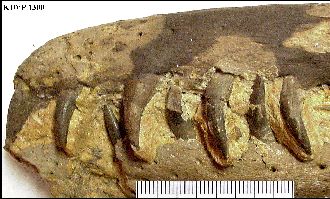 |
LEFT: The distal end of the lower jaws in left lateral view. The darker colored "bone" is part of the repairs made to the skull during preparation. |
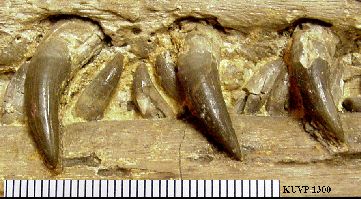 |
LEFT: Detail of some of the teeth in the left maxilla of KUVP 1300. |
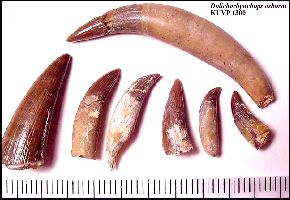 |
LEFT: Some of the other teeth recovered with the specimen. More than likely, these teeth originated in the missing right maxilla. Dolichorhynchops teeth tend to be loosely socketed and usually fall out as the tissues holding them in place disintegrate before preservation, as is shown in this early photo of the MCZ 1064 specimen (Photo by G.F. Sternberg, circa 1926) . |
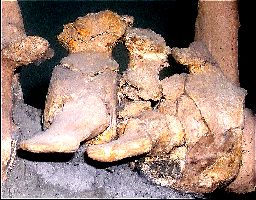 |
LEFT: Anteriormost cervical vertebrae of KUVP 1300, including the atlas/axis complex. |
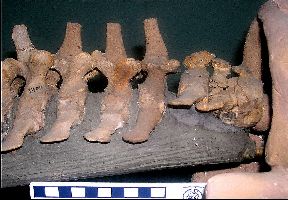 |
LEFT: A different view of the anterior cervical vertebrae of this specimen (Click here for another view). Note that the distance between the vertebrae is greatly exaggerated. Compare with the neck of the VP_404 specimen at the Sternberg Museum of Natural History. Part of the problem is in getting vertebrae that were preserved separately (and somewhat deformed) to fit back together in a realistic fashion. |
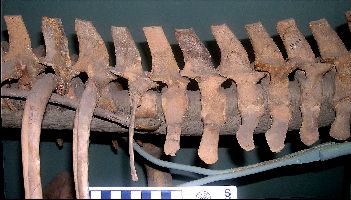 |
LEFT: The junction between the posterior cervicals and the pectoral vertebrae (transition between neck and the shoulder) |
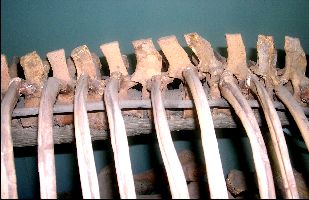 |
LEFT: Doral vertebrae over the rib cage. |
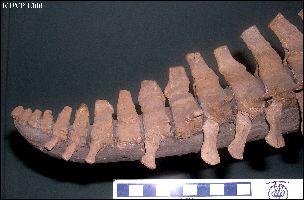 |
LEFT: The end of the tail. |
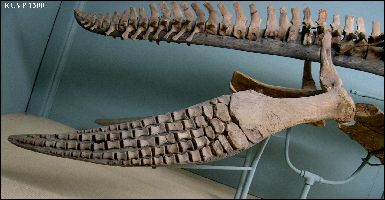 |
LEFT: Right rear paddle with part of the pelvic girdle and tail vertebrae. |
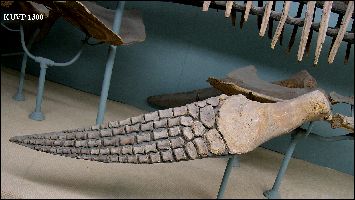 |
LEFT: Right front paddle with a portion of the pectoral girdle in the background. |
References:
Adams, D. A. 1977. Trinacromerum bonneri, a new polycotylid plesiosaur from the Pierre Shale of South Dakota and Wyoming. Unpublished Masters thesis, University of Kansas, 97 pages.
Adams, D. A. 1997. Trinacromerum bonneri, new species, last and fastest pliosaur of the Western Interior Seaway. Texas Journal of Science, 49(3):179-198.
Bonner, O. W. 1964. An osteological study of Nyctosaurus and Trinacromerum with a description of a new species of Nyctosaurus, Unpub. Masters Thesis, Fort Hays State University, 63 pages.
Carpenter, K. 1996. A Review of short-necked plesiosaurs from the
Cretaceous of the western interior, North America, Neues Jahrbuch für Geologie und
Paläeontologie Abhandlungen, (Stuttgart) 201(2):259-287.
Carpenter, K. 1997. Comparative cranial anatomy of two North American Cretaceous
plesiosaurs, pp. 191-216, In Calloway, J. M. and E. L. Nicholls, (eds.), Ancient
Marine Reptiles, Academic Press.
Cope, E. D. 1869. [Remarks on fossil reptiles, Clidastes propython, Polycotylus latipinnis, Ornithotarsus immanis.]. Proceedings of the American Philosophical Society xi p. 117. (meeting of June 18, 1869)
Cope, E. D. 1875. The Vertebrata of the Cretaceous formations of the West. Report, U. S. Geological Survey Territories (Hayden). 2:302 p, 57 pls.
Cragin, F. W. 1888. Preliminary description of a new or little known saurian from the Benton of Kansas, American Geologist 2:404-407. [Trinacromerum bentonianum]
Druckenmiller, P. S. 1998. Osteology and relationships of a plesiosaur (Sauropterygia) from the Thermopolis Shale (Lower Cretaceous) of Montana. Unpublished Masters Thesis, Montana State University.
Everhart, M. J. 2003. First records of plesiosaur remains in the lower Smoky Hill Chalk Member (Upper Coniacian) of the Niobrara Formation in western Kansas. Kansas Academy of Science, Transactions 106(3-4):139-148.
Everhart, M. J. 2004. Plesiosaurs as the food of mosasaurs; new data on the stomach contents of a Tylosaurus proriger (Squamata; Mosasauridae) from the Niobrara Formation of western Kansas. The Mosasaur 7:41-46.
Everhart, M. J. 2004. New data regarding the skull of Dolichorhynchops osborni (Plesiosauroidea: Polycotylidae) from rediscovered photos of the Harvard Museum of Comparative Zoology specimen. Paludicola 4(3):74-80.
Everhart, Michael J. 2005. Oceans of Kansas - A Natural History of the Western Interior Sea. Indiana University Press, 320 pp. ISBN: 0253345472
Everhart, M. J. 2007. Sea Monsters: Prehistoric Creatures of the Deep. National Geographic, 192 p. ISBN-13: 978-1426200854
Martin, J. E. and L. E. Kennedy. 1988. A plesiosaur from the Late
Cretaceous (Campanian) Pierre Shale of South Dakota: A preliminary report, Proc. S.D.
Acad. Sci., 67:76-79.
Moodie, R. L. 1911. An embryonic plesiosaurian propodial, Trans. Kansas Acad. Sci.
23:95-101, 9 figs, 1 pl.
O'Keefe, F. R. 2002. The evolution of plesiosaur and pliosaur morphotypes in the Plesiosauria (Reptilia: Sauropterygia). Paleobiology 28(1):101-112.
O'Keefe, F. R. 2004. On the cranial anatomy of the polycotylid plesiosaurs, including new material of Polycotylus latipinnis Cope, from Alabama. Journal of Vertebrate Paleontology 24(2):326-340.
O'Keefe, F. R. 2008. Cranial anatomy and taxonomy of Dolichorhynchops bonneri new combination, a polycotylid plesiosaur from the Pierre Shale of Wyoming and South Dakota. Journal of Vertebrate Paleontology 28(3): 664-676.
Riggs, E. S. 1944. A new polycotylid plesiosaur. University of
Kansas Science Bulletin 30:77-87.
Schmeisser,
R.L. and Gillette, D.D. 2009. Unusual occurrence
of gastroliths in a polycotylid plesiosaur from the Upper Cretaceous Tropic Shale,
southern
Schumacher, B. A. and M. J. Everhart. 2004. A new assessment of plesiosaurs from the old Fort Benton Group, Central Kansas. Abstracts of oral presentations and posters, Joint Annual Meeting of the Kansas and Missouri Academies of Science, p. 50.
Schumacher, B. A. and J. E. Martin. 1995. Polycotylus sp.: A short-necked plesiosaur from the Niobrara Formation (Upper Cretaceous) of South Dakota. Jour. Vert. Paleon. 15(suppl. to 3):52A.
Sternberg, C. H. 1909. The life of a fossil hunter. Henry Holt and Company, 286 p. (reprinted by the Indiana University Press, 1990).
Sternberg, G. F. and M. V. Walker. 1957. Report on a plesiosaur skeleton from western Kansas. Kansas Academy of Science, Transactions, 60(1):86-87.
Welles, S. P. 1962. A new species of elasmosaur from the Aptian of Columbia and a review of the Cretaceous plesiosaurs. University of California Publications in Geological Sciences 44(1):96 p., 4 pl., 23 text figures.
Williston, S. W. 1902. Restoration of Dolichorhynchops osborni, a new Cretaceous plesiosaur. Kansas University Science Bulletin, 1(9):241-244, 1 plate.
Williston, S. W. 1903. North American plesiosaurs. Field Columbian Museum, Pub. 73, Geological Series, 2(1):1-79, 29 plates.
Williston, S. W. 1906. North American plesiosaurs: Elasmosaurus,
Cimoliasaurus, and Polycotylus. American Journal of Science, Series 4,
21(123):221-234, 4 pl.
Williston, S. W. 1908. North American plesiosaurs: Trinacromerum. Journal of
Geology 16:715-735. figs. 1-15.
Williston, S. W. 1914. Water reptiles of the past and present. Chicago Univ.
Press. 251 pp